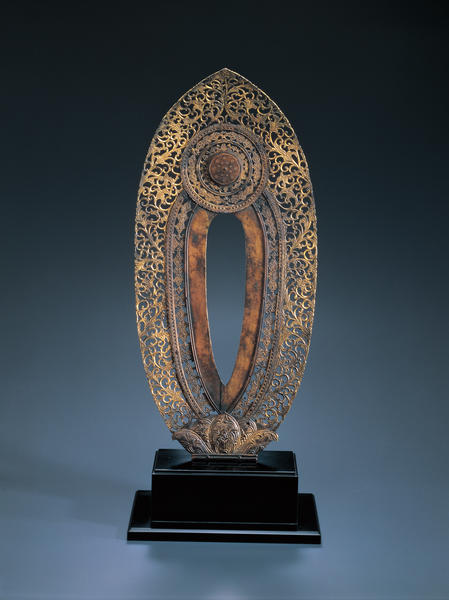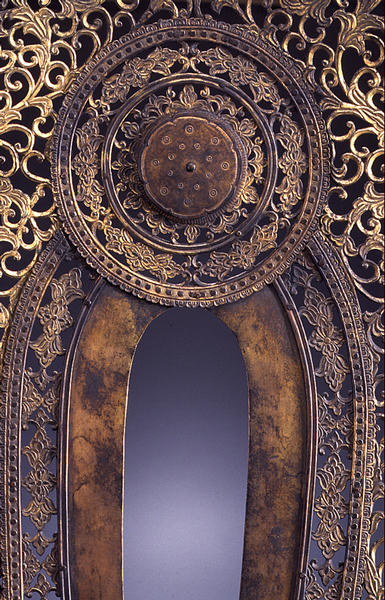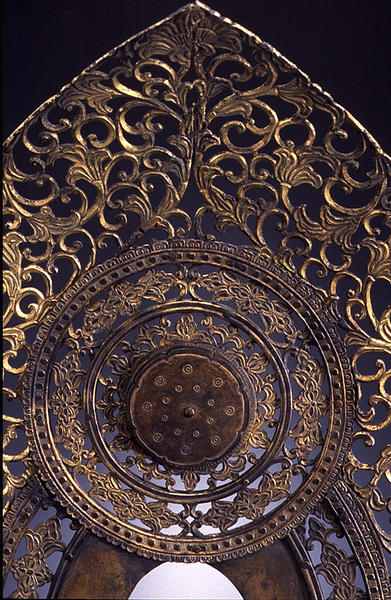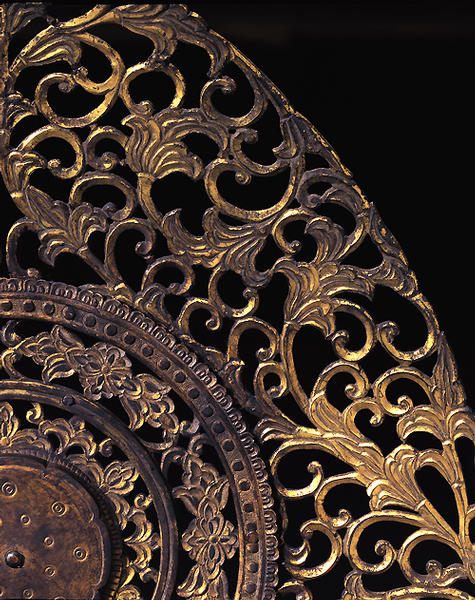金銅透彫光背
- 鎌倉時代後期
- 14c
- 金銅製
- H-57.8 W-25.8
鎌倉時代後期 14世紀
高:57.8cm 幅:25.8cm
仏像の背後を飾る光背である。光背は,仏・菩薩にそなわった人間と異なる32の特性,いわゆる「三十二相」のうちの「丈光相」にちなむもので,仏から発する後光を表したものである。
この光背は,仏像の頭部に対応する頭光,肩から足元に及ぶ身光,および頭光・身光を広く囲む周縁部,これらを基部で支える光脚部からなり,全体で船に似た形状に作っているため「舟形光」と称される。
銅板製透彫で,鍍金を施して仕上げている。頭光の中心となる蓮華,身光の最内帯,光脚,および各部を区画する連珠文帯を除いて,ことごとく透彫の唐草や宝相華文で構成しているが,いずれも破綻なく的確に表現されており,細部にまで神経をゆき届かせた作者の優れた彫金技術がうかがえる。
周縁部に配された透彫唐草文の表現は,鎌倉時代初期の滋賀・神照寺の透彫華篭や愛知・万徳寺の透彫経筒にも通ずるところがあるが,それらに比べて文様表現に若干の硬さが認められる。製作は鎌倉時代後半期であろう。(関根)
Catalogue Entry
Late Kamakura period, 14th century
Gilt bronze, open work
Height, 57.8cm; width, 25.8cm
This nimbus would have adorned the back of a Buddhist sculpture. Unlike normal mortals, Buddhas and Bosatsu (Bodhisattvas) have 32 specific aspects which indicate their sanctity, and the Emitting Light Aspect is one of these aspects. Thus, halos of light, or nimbuses, were displayed behind Buddhist images.
This nimbus is made up of the round head nimbus which would have been situated behind the figure's head, the body nimbus which would extend from the shoulders to the feet, both surrounded by a broad encompassing outer nimbus that descends to the final form of the base of the nimbus. The entire form resembles that of a boat, and hence this form of nimbus is often called a "boat-shaped nimbus."
This nimbus was created out of an openwork panel of bronze, and the overall surface has been gilded. With the exception of the lotus blossom which forms the center of the head nimbus, the inner band of the body nimbus, the base of the nimbus, and the band of connected jewels which delineates each section, the entire construct is made up of openwork karakusa vining motifs and hosoge motifs, each expressed in utter clarity. The work provides a splendid understanding of the superior openwork skills of the artist who expended considerable effort and care on the finest details of the nimbus.
The expression of the openwork karakusa vining motif which forms the surrounding edge of the nimbus is similar to that found on the openwork ritual flower basket of Jinshoji, Shiga prefecture, and the openwork sutra container of Mantokuji, Aichi prefecture, but the openwork expression on the present nimbus is somewhat harder than these examples. This nimbus probably dates from the latter half of the Kamakura period. SS



